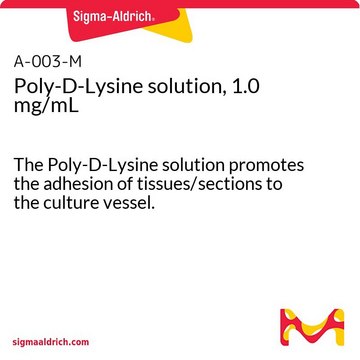P5899
Poly-ʟ-Lysine Hydrobromide
synthetic, mol wt ≥300,000, powder, γ-irradiated, suitable for cell culture, BioXtra
Synonym(s):
PDL HBr
About This Item
Recommended Products
product name
Poly-L-lysine hydrobromide, mol wt ≥300,000, lyophilized powder, γ-irradiated, BioXtra, suitable for cell culture
biological source
synthetic (organic)
Quality Level
sterility
γ-irradiated
product line
BioXtra
form
lyophilized powder
mol wt
≥300,000
packaging
pkg of 5 mg
technique(s)
cell culture | mammalian: suitable
surface coverage
4 μg/cm2
impurities
<10% water (by Karl Fischer)
solubility
H2O: soluble 50 mg/mL, clear to very slightly hazy, colorless to faintly yellow
shipped in
ambient
storage temp.
−20°C
SMILES string
Cl.NCCCCC(N)C(O)=O
InChI
1S/C18H38N6O4/c19-10-4-1-7-13(22)16(25)23-14(8-2-5-11-20)17(26)24-15(18(27)28)9-3-6-12-21/h13-15H,1-12,19-22H2,(H,23,25)(H,24,26)(H,27,28)/t13-,14-,15-/m0/s1
InChI key
WBSCNDJQPKSPII-KKUMJFAQSA-N
Looking for similar products? Visit Product Comparison Guide
Application
- 2-well plates before seeding muscle cells in a research study on rainbow trout myotube formation
- flat bottom 96-well plates for in vitro neuronal stem cell differentiation
- T75 flasks for primary astrocytic cultures
Biochem/physiol Actions
Components
Caution
Analysis Note
Other Notes
Storage Class Code
11 - Combustible Solids
WGK
WGK 3
Flash Point(F)
Not applicable
Flash Point(C)
Not applicable
Personal Protective Equipment
Certificates of Analysis (COA)
Search for Certificates of Analysis (COA) by entering the products Lot/Batch Number. Lot and Batch Numbers can be found on a product’s label following the words ‘Lot’ or ‘Batch’.
Already Own This Product?
Find documentation for the products that you have recently purchased in the Document Library.
Customers Also Viewed
Articles
Cancer stem cell media, spheroid plates and cancer stem cell markers to culture and characterize CSC populations.
Extracellular matrix proteins such as laminin, collagen, and fibronectin can be used as cell attachment substrates in cell culture.
Our team of scientists has experience in all areas of research including Life Science, Material Science, Chemical Synthesis, Chromatography, Analytical and many others.
Contact Technical Service
